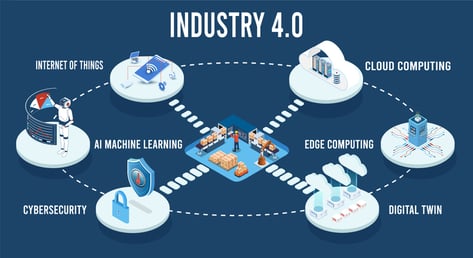Outsourcing Electronics Manufacturing: Onshore or Offshore?
It’s time for your organization to begin production of a new electronic device. For one reason or another, you’re in no position to take care of the...

In today’s world of advanced technology, it could be two days before someone detects a cyberattack on your system. At that point, data and application corruption is likely, data destruction is possible, and the impact could span manufacturing systems and client lists.
Considering the average downtime resulting from a lack of reliable cyber defense is over two weeks, the loss of income will be notable.
With the growth of the IIoT (Industrial Internet of Things), the digitalization of so much of the production planning and process and the increased reliance on system networking, Information Technology (IT) and Operational Technology (OT) are blending at a surprising rate. This means that cyber security operations and technology solutions, including having a security professional on staff and a security operation center (soc) are more important than ever.
Operational Technology (OT) security is becoming increasingly important due to the growing integration between IT and OT systems. With an effective OT security system, companies can minimize the risk of malicious activity on their networks and systems.
Information security includes regular monitoring for vulnerabilities, authentication and encryption, secure network segmentation, patch management, and network configuration management. Employing these measures helps ensure that attackers cannot gain access to critical infrastructure or disrupt operations. 
One such measure is the recording of logs. Logs are vital for tracking system activity, to ensure there is a record of events that took place not just during an attack, but also during normal business operations. They help in traceability and can be used to monitor unauthorized access attempts and malicious activities.
Backups should be conducted regularly in order to enable fast recovery from any cyberattacks or data loss. Recovery processes must also be put into place as part of any OT security strategy. These can range from simple manual steps to automated processes that can restore system functionality after an attack has occurred.
While there are security architectures that can be employed by manufacturers, such as firewalls and intrusion detection systems, many organizations still lack adequate protection against cyber threats. Therefore, manufacturers need to evaluate their current level of security to assess their risk levels and determine which areas need additional protection.
Both the National Institute of Standards and Technology (NIST) in the United States, and the European Union Agency for Cybersecurity (ENISA) have set standards for functions that will increase the security of your platform against attacks:
The prevalence of cyber-attacks means businesses can no longer do the bare minimum and hope for the best. Ransomware attacks are becoming more common, with more than 85% of organizations having suffered from at least one attack in the past 12 months
When cyber attacks occur, studies show the average cost of downtime per hour can be as high as $260,000. Around 45% of unexpected issues arise due to hardware failure, while 39% are attributed to software issues. This means the time for security solutions is before you are dealing with a cyber attack that focuses on your facility.
When it comes to company-wide best practices, there are four common areas to prioritize:
Businesses need to be adequately prepared for a cyber breach to mitigate the damage caused. Being prepared includes prevention tactics, such as implementing security measures; detecting the attack as soon as possible; and having an incident response plan in place.
It is important to create and maintain a well-thought-out cybersecurity strategy at every stage, starting with prevention measures:
Education, training, and preventative measures are essential for preventing a cyber attack on a manufacturing company. Companies should regularly review employee access rights to the company’s data and systems, and regular employee training on proper security protocols should be scheduled.
It is also important for companies to have a strong policy in place to maintain and utilize security technologies. Companies should create and maintain a plan for responding quickly and effectively to any security incidents that may occur. By taking the necessary steps to protect against and respond to cyber security threats, companies can keep their networks and data safe.
Learn more about Matric’s capabilities in electronics manufacturing:

It’s time for your organization to begin production of a new electronic device. For one reason or another, you’re in no position to take care of the...

Two things are fairly certain about the current electronic component shortage: It’ll end, and it’ll someday return.

If there's anything certain in the U.S.-China tariffs staredown, it's uncertainty.